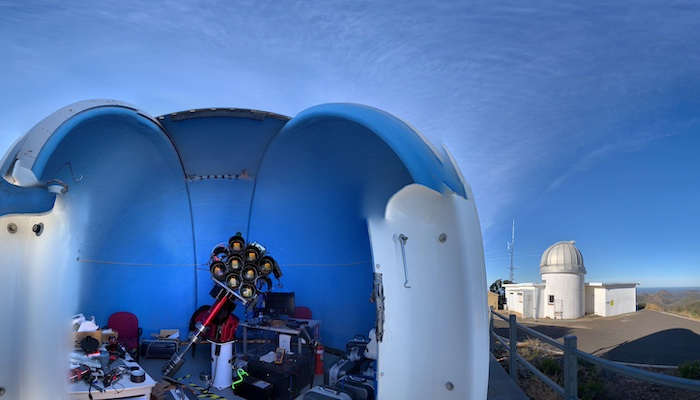This telescope can observe stars, satellites and more during the day. But how?
"Our tests show the Huntsman can achieve remarkable results in daylight hours."

An innovative telescope design has proven successful for daytime skywatching, opening new doors for uninterrupted observation of the cosmos.
Astronomers at Macquarie University in Australia have developed a new technique using light filters on the school's multi-lens Huntsman Telescope. Originally designed for ultra-sensitive night sky observations, the telescope has demonstrated an ability to accurately measure stars, satellites and other targets in broad daylight.
"People have tried observing stars and satellites in optical wavelengths during the day for centuries, but it has been very difficult to do," Sarah Caddy, who helped design and build the Huntsman Telescope, said in a statement from the university. "Our tests show the Huntsman can achieve remarkable results in daylight hours."
Related: The 15 must-see skywatching events of 2024
The Huntsman Telescope, located at Siding Springs Observatory in the New South Wales town of Coonabarabran, combines an astronomy camera and astro-mechanical focusing equipment with a unique array of 10 highly sensitive 400mm Canon lenses. The lenses are oriented to work in parallel to monitor the same area of sky and capture thousands of short-exposure images per second, which are then processed by an attached camera, according to the statement.
Generally, sunlight drowns out dim planets, stars and galaxies, so ground-based observatories are limited to nighttime viewing. However, using special broadband filters with the Huntsman Telescope, the astronomers were able to block most daylight while still allowing specific wavelengths from celestial objects to pass through.
The researchers tested their filter method on a mini-Huntsman single-lens pathfinder telescope for months to study optimal exposure times, observation timing and precise tracking of targets through atmospheric turbulence.
Get the Space.com Newsletter
Breaking space news, the latest updates on rocket launches, skywatching events and more!
One of the researchers' targets was the red supergiant star Betelgeuse, located about 650 light-years from Earth. This star has been the focus of recent interest since it exhibited a sudden change in brightness in 2019. This activity, believed to be the result of a mass ejection of material into space that formed a dust cloud that temporarily obscured the star's light, suggests the star is getting ready to explode in a supernova.
"This breakthrough paves the way for uninterrupted, long-term studies of stars like Betelgeuse as they undergo powerful eruptions near their end of life, expelling massive amounts of stellar material in the final stages of the cosmic cycle of rebirth," Lee Spitler, co-author of the recent study and associate professor at Macquarie University, said in the statement. "Astronomers love when stars in the Milky Way go supernova because it can tell us so much about how elements are created in the universe."
Daytime observations also allow for continuous monitoring of satellites, space debris and other artificial objects orbiting Earth and to help prevent potentially harmful collisions.
"With around 10,000 active satellites already circulating the planet and plans to launch a further 50,000 low Earth orbit satellites in the next decade, there's a clear need for dedicated day and night telescope networks to continually detect and track satellites," said Caddy, lead author of the recent study using Huntsman for daytime observations. "Daytime astronomy is an exciting field, and with advances in camera sensors, filters and other technologies, we saw dramatic improvements in the sensitivity and precision achievable under bright-sky conditions."
Their findings were published May 20 in the Publications of the Astronomical Society of Australia.
Join our Space Forums to keep talking space on the latest missions, night sky and more! And if you have a news tip, correction or comment, let us know at: community@space.com.

Samantha Mathewson joined Space.com as an intern in the summer of 2016. She received a B.A. in Journalism and Environmental Science at the University of New Haven, in Connecticut. Previously, her work has been published in Nature World News. When not writing or reading about science, Samantha enjoys traveling to new places and taking photos! You can follow her on Twitter @Sam_Ashley13.








